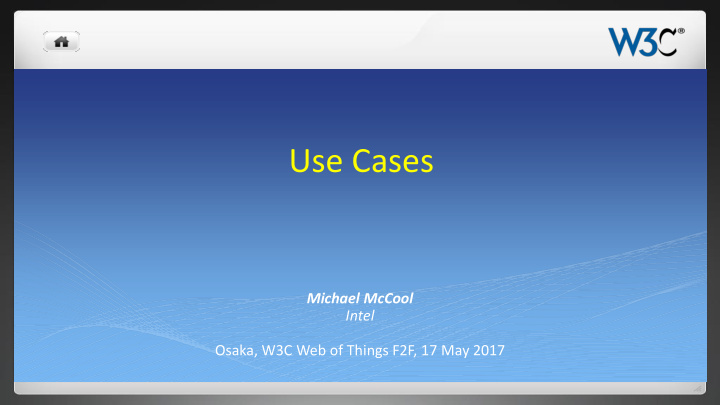



Use Cases Michael McCool Intel Osaka, W3C Web of Things F2F, 17 May 2017
Outline Discuss Process and Goals Gather/Brainstorm Prioritize Derive Requirements Incorporate into Plan Security Objectives 2/37
Goals Use cases as a basis for justifying design choices in our specifications For example, for security Use cases as a basis for growing mindshare and building a concrete understanding Use cases to drive recruiting Concrete examples and demonstrations of value 3/37
Needs Drive requirements and test cases Simple use cases to explore the base data types, interactions, and architecture needs Complex use cases to test boundaries Including “pathological” test cases to find failure modes Distributed use cases Multi-device use cases Lifecycle use cases Different audiences and contexts Use cases that demonstrate value of advanced processing For example, contextual information, semantic modelling and processing, etc. 4/37
Example Contexts Smart Home Smart Building Smart City Smart Factory Smart Ship… Smart {{Noun}} 5/37
Other Dimensions Simple to Complex Local to Global Trusted to Untrusted Number of Devices Number of Ecosystems Asynchronous (Deliver Whenever) vs Synchronous (Real Time Delivery) Lossy vs Guaranteed 6/37
Issues to Test Dependency Chains Distributed Race Conditions Translation of information and possible loss of meaning and capabilities Performance Time Quality of Service Scaling to “Big Data” Streaming Data and Real Time 7/37
Context: Smart Home Connection of personal devices owned by a family (need to develop personas…) Some devices installed in house, some owned by family, some by individual family members Behind a gateway/firewall, connected by WiFi Assume gateway has adequate but not perfect security Firewall with port 80 open, non-default password WiFi using WPA2 security Gateway with some capability for running computations, eg. bridges, small services Scenarios: Onboarding a new device, controlling a single device, services coordinating multiple devices from different ecosystems, family member moving to a new household, visiting guest needing access to a subset of devices 8/37
Context: Smart City Constellation of smart buildings as well as city infrastructure: roads, lighting, water, electricity, transit, police and fire control. System integrator needs to combine systems from various manufacturers Needs to deal with large-scale system monitoring and maintenance, mass upgrades, etc. Use of system to coordinate and inform maintenance, security, and safety activities Combinations of communications technologies: 4G, LoRA, WiFi, Zigbee, wired ethernet, etc. Scenarios: Adding new devices, retiring old devices, upating devices, reponse to need for maintenance of monitored infrastructure, emergency response to earthquake, coordination of police/fire response. 9/37
Context: Smart Factory Combination of IT and OT services – See IIC SF Need to satisfy strict safety requirements Brownfield systems, pre-IoT OT systems Need to enable data-driven decision making Scenarios: Onboarding and offboarding, monitoring, safety notifications, functional safety certification, real-time control, security monitoring See IICSF 10/37
Discussion Large number of possible use cases - need to focus on ones that add value What are we going to do with them? Do we publish them? Just to drive requirements? Can we reuse use cases from elsewhere? BIGIoT (city, automotive); IIC (industrial) Use cases to use for marketing need to demonstrate differentiation and key value. Architecture scenarios: T2T, T2C, T2B; which are “typical” Demonstrate how interoperability can enable a larger cross-domain ecosystem Eg Smart Home in the Smart City (eg OCF device in the home, connects to city emergency infrastructure) 11/37
Discussion How should be describe use cases? General or specific? What granularity? Atomic use cases: small scenarios that occur in many domains. Handover between domains Example of an issue a use case would let us explore Use cases can take a long time to develop, normally done early 12/37
Next Steps (Proposals) Do a study of existing Use Case collections in IoT (AR: MM to create Pull request in IG github) Identify use cases where WoT would add value Where do we already have use cases? Historical, down in arch document, security, etc. Key Value Brainstorm some example use cases that demonstrate it build Demos/Simulations Permanently running HW; online simulation; downloadable sim; Instructables to build; WoT SDK Build database Optionally publish, link to requirements, using template etc. But: infinite scope Collaborate within W3C eX: Autmotive group, device and sensor group 13/37
Recommend
More recommend